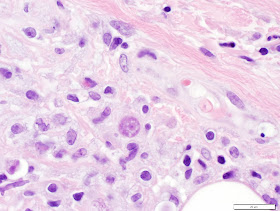The following is a skin biopsy from an ulcerating lesion on the left thigh of a 70 year old woman. She is being treated with chemotherapy for diffuse large B cell lymphoma.
Hematoxylin and Eosin (H&E), 20x magnification

H&E, 40x
H&E, 400x
H&E, 400x
H&E, 1000x



Gomori Methenamine Silver (GMS), 1000x






The pictures at the highest magnifications point towards amoebic infection, in particular the interior hexagonal shape resembles those of Acanthamoeba cysts. The true etiology remains to be learned.
ReplyDeleteFlorida Fan
The last 2 pictures show an amoebic form with wrinkled membrane suggestive of Acanthamoeba sp. it is well known as an agent of Granulomatous amoebic encephalitis. The location of the infection in this case the thigh is very unusual.
ReplyDeleteJamal.
Acanthamoeba sp. or Balamuthia mandrillaris.
ReplyDeleteI never learned how to tell them apart.
-AMPc
could this be a histoplasma infection? would go hand in hand with the suppressed immunity from the chemo, Histoplasma can cause ulcerating lesions in immunosuppressed patients and it looks like a positive GMS stain which is supposed to be good for picking up carbohydrates such as those found in fungal cell walls, I think?
ReplyDeleteWell, the morphology is more consistent with an amebic infection, the polygonal shapes are those of the cyst stage and we did see some uni-nuclear trophozoite forms.
ReplyDeleteThere are no small yeast form 2-4 micron size to prove a diagnosis of histoplasmosis.
Florida Fan
Considering the appearance of the typical "star-like" cysts I think it's Acanthamoeba sp. which may cause skin infections as well (though it's not so common).
ReplyDeleteFirst reaction was Acanthamoeba, but due to the unusual placement of the ulcer I considered Balamuthia mandrillaris as this is fairly similar to another case I have read about. However given the immunocomprimised state of the patient, the amoebae will pretty much run riot wherever they find themselves. With that in mind I am leaning towards a rather unusual Acanthamoeba infection.
ReplyDelete